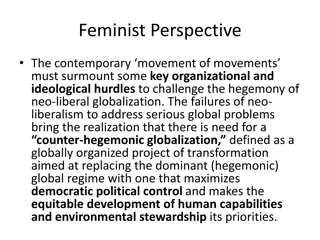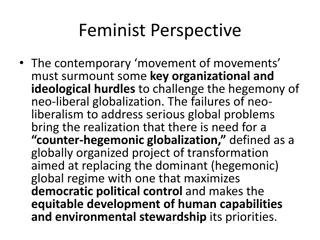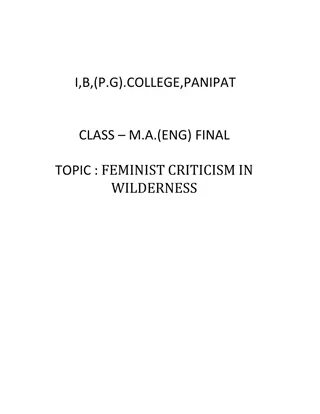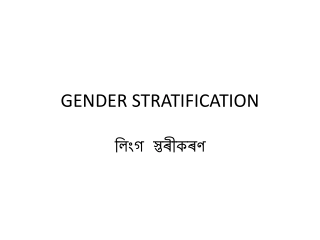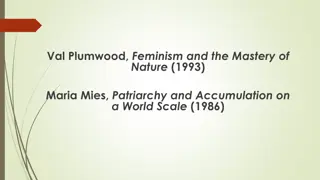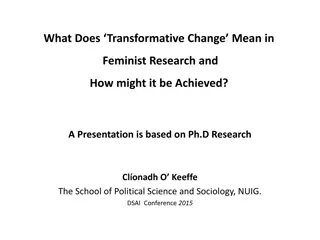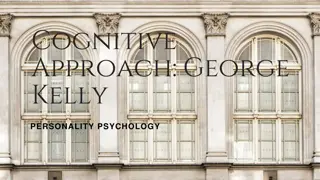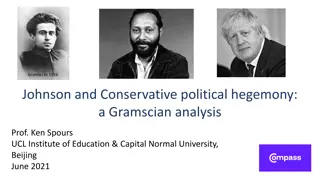Understanding Feminist Political Theory and Gender Constructs
Feminist political theory seeks to redefine politics by addressing the power dynamics between men and women. The distinction between sex and gender highlights how societal attitudes, influenced by patriarchy, shape gender roles and behaviors. These constructs serve as tools of social control, perpetuating male dominance. By challenging these norms, feminist thought aims to bring about gender equality and social change.
Download Presentation

Please find below an Image/Link to download the presentation.
The content on the website is provided AS IS for your information and personal use only. It may not be sold, licensed, or shared on other websites without obtaining consent from the author. Download presentation by click this link. If you encounter any issues during the download, it is possible that the publisher has removed the file from their server.
E N D
Presentation Transcript
Introduction Feminism is a mode of thought which is concerned with the condition of women in society, the causes of their suffering and deprivation and the measures for restoring their due position. Feminist political theory insists on redefining the nature of the political with a view to bringing the relation between men and women in society into the domain of the political . In the past, politics was concerned with the exercise of power within the public sphere. The power exercised by men over women in domestic sphere, work-place, school or street was excluded from its purview as it belonged to private sphere.
Introduction (contd.) According to the feminists this dichotomy between public and private led to a distorted view of political theory which must be rectified now. Women have suffered and are still suffering injustice because of their sex which is the product of the institution of patriarchy, and not based on reason.
Sex and Gender When the term sex is used, its scope is limited to biological differences between men and women, such as reproductive function and secondary characteristics like body hair and breast development. But the term gender refers to cultural ideas that construct images and expectations of both males and females. Nature has divided human race between men and women, but their status and role in society are determined by our culture. Culture usually refers to a certain distinctive features of different groups. However, some typical attitudes towards gender can be found throughout the civilized world.
Sex and Gender (contd.) These attitudes tend to divide male and female personality traits and behavioural tendencies into two opposite patterns (masculinity and femininity). The relative assertiveness of man and submissiveness of woman represent almost universal cultural traits which are not directly based on their biological differences. Broadly speaking, these are the products of the social organization based on patriarchy and its institutions, division of labour in the family and the competitive and exploitative character of the contemporary capitalism.
Sex and Gender (contd.) From this perspective, the concepts of masculinity and femininity serve as instruments of social control that reinforce male dominance. Thus, the division of society into two sexes-male and female-represents natural inequality, but gender inequalities are the product of convention and culture which can be altered by changing the social arrangements. With the development of technology, sweeping changes have taken place in other parts of social organization, but the division of labour between men and women has remained, more or less, unchanged.
Hegemonic Structures in Patriarchy It may be recalled that at the early stages of social organization, biological differences between men and women necessitated the division of labour between them according to the prevailing conditions. Men who were physically strong and stable chose to go out for hunting and other hazardous tasks. Women who were constrained to undertake child-bearing and child-rearing chose to remain at home and perform household jobs. The system was based on mutual care and adjustment, and did not involve any significant level of resentment.
Hegemonic Structures in Patriarchy (contd.) As mentioned earlier development of technology brought sweeping changes in other parts of social organization, but the division of labour between men and women remained almost unchanged. Woman was considered sexually vulnerable, she was not allowed to mix with strangers. Shyness was eulogized as a woman s ornament. She was encouraged to decorate herself and her beauty was admired in poetry and music, and epitomized in paintings, sculpture and other works of art. In civilized society, she was recognized as the fair sex , endowed with special dignity. Manners like ladies first were evolved to confirm that dignity. Helping a damsel in distress was regarded as an act of chivalry among men.
Hegemonic Structures in Patriarchy (contd.) But the fact that it was all notional and only for namesake became evident when one probes into the real happenings on the ground. In spite of so much importance accorded to women, but only in words, she was systematically deprived of her share in power. She was given security but not an opportunity to learn certain things that would make her as competent as man, and thereby vindicate her claim to equality. In particular, she was deprived of the right to ownership of property, right to vote and opportunities of education and higher learning even though these deprivations had no logical connection with her biological status as a woman.
Broad Streams within the Feminist Perspective The first wave of feminism which arose in late nineteenth century and lasted up to the early part of the twentieth century, concentrated upon either achieving political representation or social emancipation of women. The second wave appeared in late twentieth century which set out a radical agenda and sought emancipation of women in all spheres of life. Feminist theory has evolved, broadly, into three schools of thought: (a) Liberal Feminism; (b) Socialist feminism; and (c) Radical feminism. Recent trends in this field are broadly described as post-feminism or post-modern feminism.
Liberal Feminism Liberal feminism advocates suitable reforms in the liberal institutions already existing in Western countries. It opposes any revolutionary change and seeks amelioration in the condition of women in pursuance of the policy of liberalism. When Mary Wollstonecraft (1759-97) published her essay A Vindication of the Rights of Woman (1792), she sought to establish fundamental equality between men and women within the existing framework of liberal democracy. She argues that both man and woman are essentially rational creatures. But women were deprived of education as well as opportunity to participate in public life. Under the circumstances, woman was cast in the image of an emotional and playful creature rather than a rational creature.
Liberal Feminism (contd.) Wollstonecraft established the principles on which campaigns for women s right to education, employment, property and vote were later built up. John Stuart Mill (1806-73) in his noted work The Subjection of Women (1869), sought to demonstrate that women were in no way inferior to men in their talents, and pleaded to give them full legal and political rights. According to Mill society as a whole loses if it does not make good use of the rational qualities of women as well as men. He was of the opinion that a more equal relationship between man and woman would ameliorate the qualities of life for both men and women.
Contemporary Exponents of Liberal Feminism Betty Friedan (1921-2006), an American writer and activist is an important figure who, in her famous work The Feminine Mystique (1963), argues for measures to ensure substantive equality for women in the world of work as well as politics and private life. In The Second Stage (1983), she underlines the continued significance of home, family and children for women. Friedan asserts that the liberal creed of autonomy and self determination of the individual should be applied to women as well as men. She advocates widespread access to cr che and similar facilities to enable women to combine effectively professional careers and family responsibilities. Friedan is regarded as an inspirational figure for second-wave liberal feminists.
Contemporary Exponents---- (contd.) Carole Pateman (1940- ) is widely known for her synthesis of conceptual problems in liberal democratic theory with the theory of the patriarchal basis of sexual politics. In her famous essay The Sexual Contract (1988), she particularly attacks the misconception that the liberal theory of the Social Contract has overthrown the concept of patriarchal rule. Pateman argues that all exponents of the theory of the social contract deem women as incapable of moving from natural to civil society except as subordinates of men.
Contemporary Exponents---- (contd.) In maintaining that the relations between the sexes are private, liberal theorists have sought to remove the subject from political inquiry. Unless we acknowledge that women in liberal society are individuals in the same way as men, the reforms designed to give freedom of contract to women similar to that given to men will not fundamentally alter the sexual basis of the social contract. Pateman has pleaded for the reconstruction of a social contract which would ensure substantive equality between men and women. Thus, liberal feminism accepts the liberal assumptions about the value to be accorded to individuality and freedom, but campaigns to achieve their equal realization for women as well as men.



